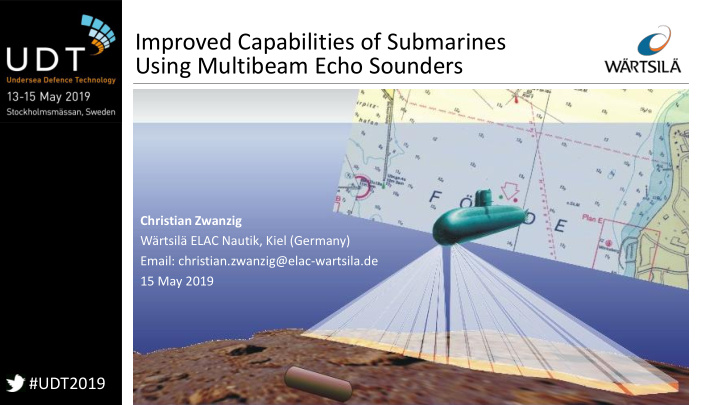



Improved Capabilities of Submarines Using Multibeam Echo Sounders Christian Zwanzig Wärtsilä ELAC Nautik, Kiel (Germany) Email: christian.zwanzig@elac-wartsila.de 15 May 2019 #UDT2019
Content • Introduction • Features of Multibeam Echo Sounders • Benefits of Multibeam Data • Interoperability • Open System Architecture • Processing Environments • Ruggedizing • Conclusions #UDT2019
Introduction (1/2) Submarines include several types of sonar systems. Cylindrical Sonar Mine Avoidance Sonar Data Fusion Intercept Sonar Flank Array Sonar TMA Situation Picture Towed Array Sonar Radar Fire Control ESM Communication Decoy Missile Torpedo #UDT2019
Introduction (2/2) In recent tenders for submarine new buildings and retrofits, also multibeam echo sounders (MBES) have been requested. They may replace the single-beam echo sounders usually installed on submarines. #UDT2019
Features of Multibeam Echo Sounders • Very popular in the commercial maritime business • Very accurate high-resolution data : o Bottom depth data o Side scan data o Bottom backscatter data o Water column imaging (WCI) data • Cost-efficient , especially compared to systems which are solely dedicated to military use • Low probability of intercept due to a small along-track beam width. #UDT2019
Benefits of Multibeam Data Accurate and up-to-date multibeam data of the seafloor and the water column are beneficial for the following submarine applications : 1. Terrain contour matching 2. Covert ISR missions in hostile waters 3. Mission planning in confined waters 4. Sonar performance predictions 5. Bottoming procedures #UDT2019
1. Terrain Contour Matching Terrain contour matching (TERCOM) compares pre- recorded bottom maps with bottom data, acquired during the mission. TERCOM can significantly increase navigation accuracy , compared to solely using an inertial navigation system (INS). #UDT2019
2. Covert ISR Missions Covert ISR missions in unknown hostile waters require a precise knowledge of the bottom topography. Especially in areas where nautical charts are not available, multibeam data are of great importance. Multibeam data, acquired by ELAC SeaBeam 3050 on R/V POSEIDON during cruise POS526 in 2018 #UDT2019
3. Mission Planning In order to avoid hazardous situations, mission planning in confined and shallow waters requires precise seafloor information. MBES can provide the required data. Main window of HYPACK software #UDT2019
4. Sonar Performance Predictions Sonar performance predictions are essential for an overview of the true situation. They require information on the bottom topography which can be provided by MBES. #UDT2019
5. Bottoming Procedures (1/2) The risk of damaging a submarine during bottoming is high, especially in uncharted or inaccurately charted areas with a rugged topography. #UDT2019
5. Bottoming Procedures (2/2) Objects lying on a flat and sandy bottom are difficult to detect with a conventional echo sounder, leading to an increased risk. Bathymetric multibeam data and WCI data, based upon cyclical transmit swath steering, can provide detailed information on the seabed within a dedicated area below the submarine before bottoming is started. This information increases the safety of the submarine especially in unknown waters. #UDT2019
Water Column Imaging (WCI) Water column imaging (WCI) is a standard functionality of modern multibeam echo sounders. WCI data are very helpful for identifying objects on the bottom or in the water column beneath a submarine. WCI data with a gas flare from the North Sea, acquired by ELAC SeaBeam 3050 on R/V POSEIDON in October 2017 #UDT2019
Cyclical Transmit Swath Steering Modern MBES provide an automatic cyclical steering of the transmitted swaths from bow to aft and vice versa. Herewith, an area below the submarine can be automatically insonified, without requiring any movement of the submarine . #UDT2019
Interoperability Interoperability of all systems onboard a submarine is essential. Therefore, the MBES must have at least a CMS interface for the following purposes: • Data exchange • Receiving control messages like the captain’s key message, initiating an immediate disruption of active pulse transmission. Data MBES CMS Control Messages #UDT2019
Open System Architecture (1/2) For an extensive interoperability, it is advantageous if the interfaces and the internal structure of the MBES are based upon an open system architecture . A common middleware standard is the Data Distribution Service for Real-Time Systems (DDS) , released by the Object Management Group (OMG). #UDT2019
Open System Architecture (2/2) DDS defines a data- centric publish- Domain subscribe (DCPS) Application 1 Application 2 QoS service for efficiently Participant Participant distributing data Topic Publisher Subscriber between participants Data Writer Data Reader in a distributed Data Structure application. QoS Quality of Service #UDT2019
Processing Environments (1/2) There is an increasing trend that system integrators provide an open system architecture processing environment (e.g. ARCI from Lockheed Martin) which should be used by all onboard sonar systems. On the processing environments, “ big sonar data ” are available, comprising all sonar information for maximum customer value of current and future applications. #UDT2019 ARCI Acoustics Rapid COTS Insertion
Processing Environments (2/2) Comprehensive onboard processing environments call for a new MBES system architecture in the future: • Smart hydroacoustic transducers will include Processing Environment … signal conditioning with Multibeam App Virtual Machines minimum information loss. • The other multibeam Ethernet, Power DDS functions will be included in software applications ( “ apps ” ), installed on the Smart Smart Smart … Transducer Transducer Transducer processing environment. #UDT2019
Ruggedizing MBES are usually COTS products which are installed on commercial vessels. For submarines, ruggedized and pressure-tight multibeam transducers have to be provided. If an existing open system processing environment is utilized, then the costs for ruggedizing electronic devices are eliminated. #UDT2019
Conclusions MBES have high benefits for the operational capabilities of submarines. The trend towards open system processing environments will increase the benefits and the integration of multibeam data into the overall onboard systems. In the future, there may be “multibeam apps” available on the market which utilize already existing onboard sonar transducers instead of specific multibeam transducers. #UDT2019
Thank You #UDT2019
Recommend
More recommend